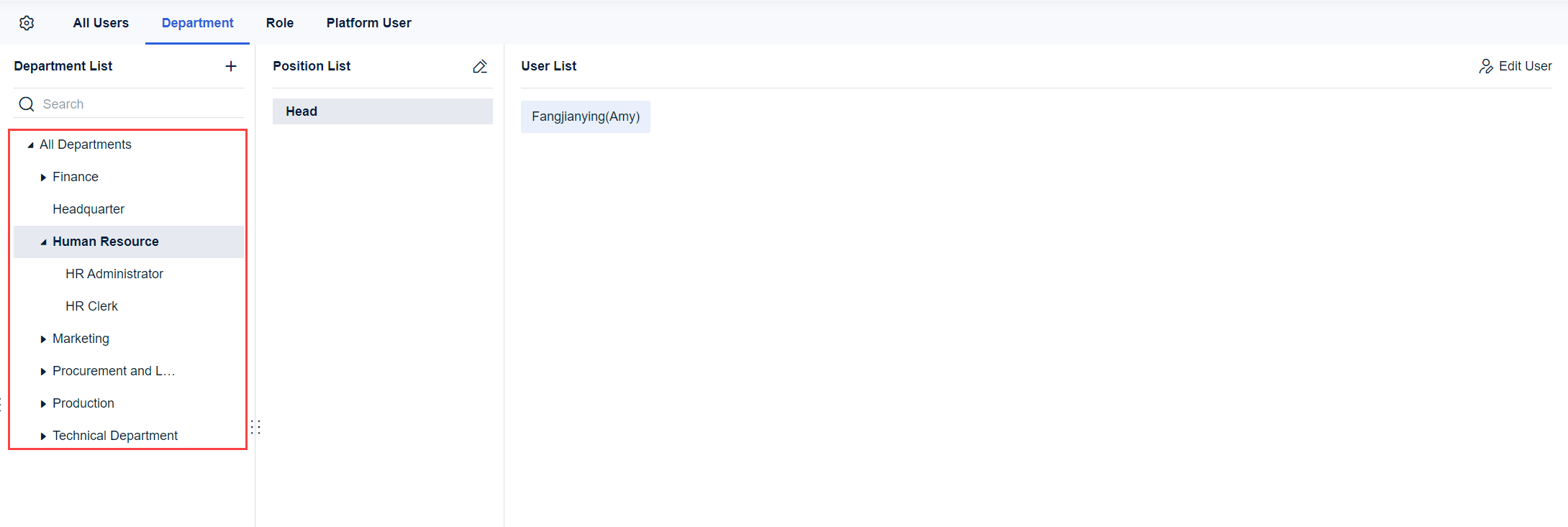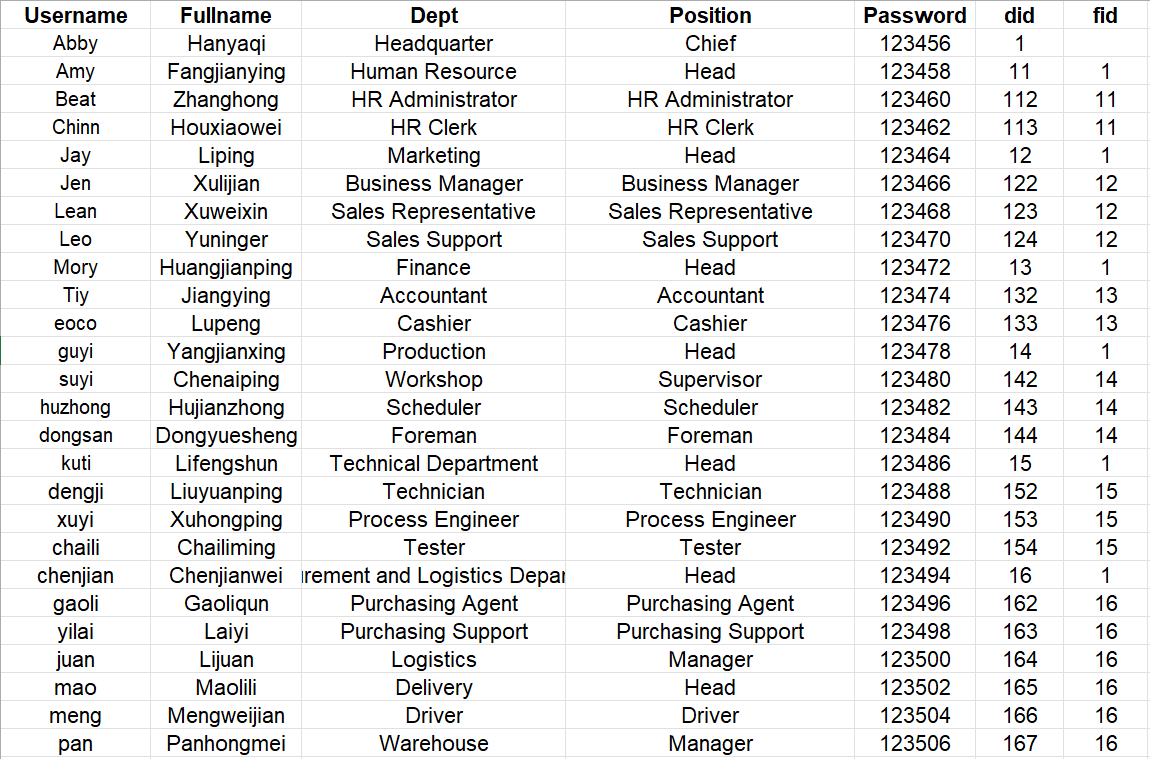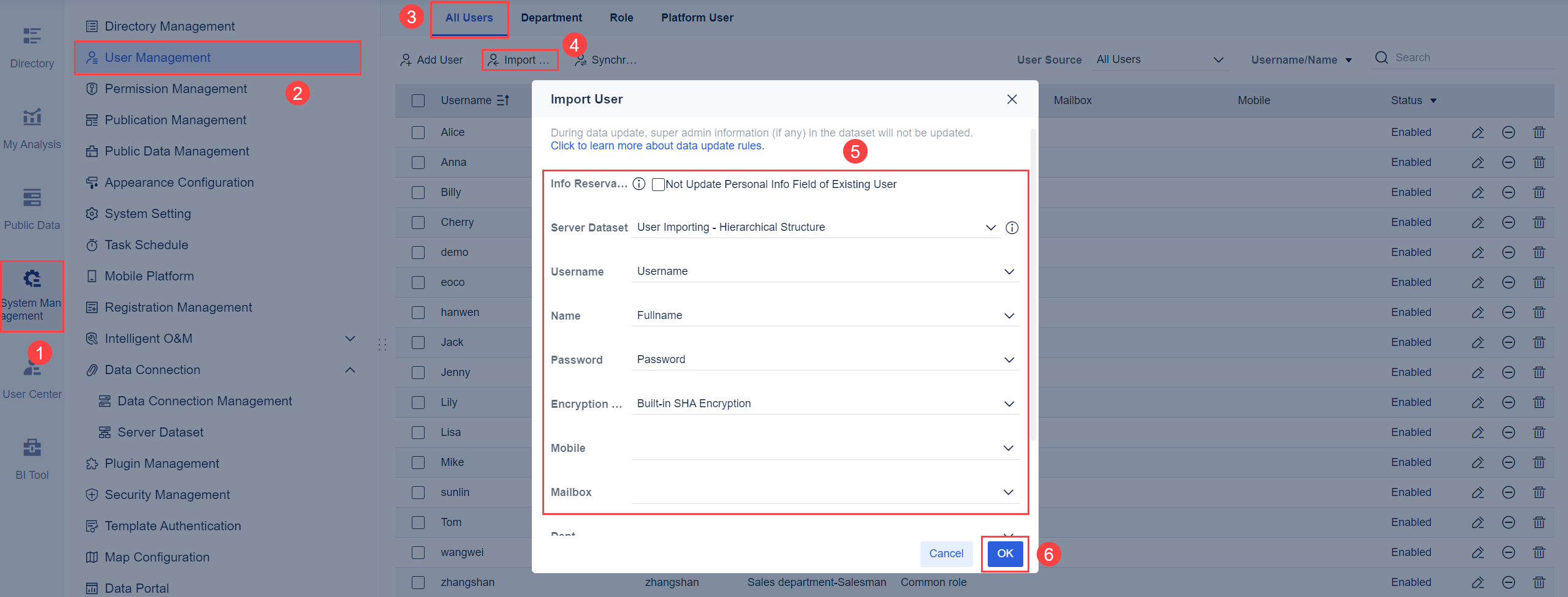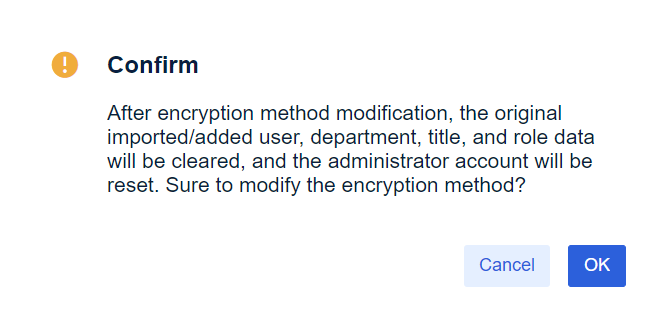Overview
Version
FineBI Server Version | Functional Change |
6.0 | / |
Application Scenario
Admins can import the organized user information table into the FineBI system at one time.
Admins can import data of user information, departments, and roles multiple times.
Admins can edit, disable, or delete imported user data.
You want user data in the FineBI system to come from a collection of multiple datasets.
Function Description
You can create a server dataset based on a user information table, and import the user information into the FineBI system. After importing user information, if you want to add or delete user data in the server dataset, you need to manually import the user information again. Platform user data can come from a collection of multiple datasets.
Previously added/imported user data will not be cleared if you do not switch encryption methods during dataset importing.
Preparation for User Data Importing
Imported user data comes from server datasets, which support data of hierarchical and non-hierarchical user department structures.
You can choose different server datasets based on user structures.
Non-Hierarchical Data Structure - SQL Dataset
The user information table used in this example has no hierarchical structures between departments and positions. To-be-imported data of user departments are all listed under All Departments, as shown in the following figure.

Preparing a User Information Table
Prepare a user information table. The following figure shows the table structure.
Click and download the user information table: user_importing_one.xlsx.
 Note:
Note:1. During user data importing, Username, Name, and Password are required fields, and other information can be left blank.
2. User mobile numbers from Mainland China, Taiwan (China), Hong Kong (China), Turkey, South Korea, Japan, Singapore, and Malaysia are supported to be bound.
Mobile numbers in mainland China do not need area codes (you can include the code if you want), while those in other regions do.

Creating a Server Dataset
You can use a third-party database management tool to import the above table into a database and establish a data connection between the FineBI system and the database. The following content takes a created database as an example.
Log in to the FineBI system as the admin and choose System Management > Data Connection > Server Dataset > Create Dataset > SQL Dataset.

Set Dataset Name to user_importing_one, set Data from Data Connection to MySQL, and enter the SQL statement.
SELECT * FROM user_importing_one

Non-Hierarchical Structure - File Dataset
The user information table used in this example has no hierarchical structures between departments and positions. To-be-imported data of user departments are all listed under All Departments, as shown in the following figure.

Preparing a User Information Table
Prepare a user information table. The following figure shows the table structure.
Click and download the user information table: user_importing_one.xlsx.
 Note:
Note:1. During user data importing, Username, Name, and Password are required fields, and other information can be left blank.
2. User mobile numbers from Mainland China, Taiwan (China), Hong Kong (China), Turkey, South Korea, Japan, Singapore, and Malaysia are supported to be bound.
Mobile numbers in mainland China do not need area codes (you can include the code if you want), while those in other regions do.
3. You can also use TXT/XML files. For details, see File Dataset.

Creating a Server Dataset
Save the table locally or upload it to the BI project path %BI_HOME%\webapps\webroot\WEB-INF\reportlets.
Log in to the FineBI system as the admin and choose System Management > Data Connection > Server Dataset > File Dataset.

Set Dataset Name to User Importing - File and select the table prepared in the section "Non-Hierarchical Structure - File Dataset."
 Note:
Note:1. If you select Server File, you need to select the file in the BI project path %BI_HOME%\webapps\webroot\WEB-INF\reportlets.
If you select Local File, after you upload the table file, the file will be automatically saved to the BI project path %BI_HOME%\webapps\webroot\WEB-INF\reportlets\excel.
2. You can also use TXT/XML/remote URL files, which support dataset parameter setting. For details, see File Dataset.

Hierarchical Structure - Tree Dataset
The user information table used in this example has hierarchical structures between departments and positions. The following figure shows the departments of imported users.

Preparing a User Information Table
Prepare a user information table. The following figure shows the table structure.
Click and download the user information table: user_importing_two.xlsx.
 Note:
Note:1. During user data importing, Username, Name, and Password are required fields, and other information can be left blank.
2. User mobile numbers from Mainland China, Taiwan (China), Hong Kong (China), Turkey, South Korea, Japan, Singapore, and Malaysia are supported to be bound.
Mobile numbers in mainland China do not need area codes (you can include the code if you want), while those in other regions do.
3. If the server dataset is the tree dataset during user dataset synchronization, the value of the parent organization of the top-level organization should be Null (not an empty value). The fid field value for user Abby is empty, as shown in the following figure.
4. You can still generate tree datasets and synchronize users if the table does not contain user information in departments. For example, the headquarters only have subordinate departments without direct positions and users.

Creating a SQL Dataset
You can use a third-party database management tool to import the above table into a database and establish a data connection between the FineBI system and the database. The following content takes a created database as an example.
Log in to the FineBI system as the admin and choose System Management > Data Connection > Server Dataset > Create Dataset > SQL Dataset.

Set Dataset Name to user_importing_two, set Data from Data Connection to MySQL, and enter the SQL statement.
SELECT * FROM user_importing_two

Creating a Tree Dataset
Log in to the FineBI system as the admin and choose System Management > Data Connection > Server Dataset > Tree Dataset.

Set Dataset Name to User Importing - Hierarchical Structure, set Source Dataset to user_importing_two, set Original Tag Field to did, and set Parent Tag Field to fid, as shown in the following figure.
 Note:
Note:
Importing User
Log in to the FineBI system as the admin and choose System Management > User Management > All Users > Import User to configure user information.

The following contents show the specific setting items.
Info Reservation
Scenario | Selection | Result |
Users existing in server datasets, not on the platform | / | User information is updated to the platform during user importing. |
Users existing on the platform, not in server datasets | / | User information on the platform remains unchanged during user importing. |
Users existing in server datasets and on the platform The current users on the platform come from synchronized users. | / | If duplicate data exists between imported users and synchronized users, the duplicate data will fail to be imported and updated. |
Users existing in server datasets and on the platform The current users on the platform come from manually added users or imported users. | Info Reservation unselected | Data of the usernames, mobile numbers, mailbox addresses, and passwords of users are updated. Data of departments and roles of users is incrementally updated. Overlapped user information between the original platform and server datasets is retrieved. |
Info Reservation selected | Data of the usernames, mobile numbers, mailbox addresses, and passwords of users are not updated. Data of departments and roles of users is incrementally updated. Overlapped user information between the original platform and server datasets is retrieved. |
Server Dataset
Server Dataset allows you to select different server datasets corresponding to user information.
Field Name
Username, Name, Password, Dept., Position, Role, Mobile, and Mailbox are the field names in the corresponding server dataset.
 Note:
Note:1. User email information configured in User Management can be used under System Management > System Setting > Mailbox, where you can send emails to mailboxes of different platform users.
2. Configured Dept. and Position cannot be reverted to unselected states unless you delete and re-select them.
3. You should configure Dept. only, no Position.
Encryption Method
 Note:
Note:After users are imported, the login passwords for users are the passwords listed in the user information table in the section "Non-Hierarchical Structure - SQL Dataset.", not the encrypted passwords in the fine_usertable.
You can select two encryption methods: Built-in SHA Encryption and Custom Password Encryption.
1. Built-in SHA Encryption
The FineBI system applies SHA256 encryption to ensure password security.
After you customize and modify a password through an interface, the password will be automatically encrypted using SHA256.
2. Custom Password Encryption
Custom Password Encryption refers to customizing a password encryption class where the encryption method is described. The .class file is saved in the path %FineBI%\webapps\webroot\WEB-INF\classes.
The FineBI system will perform a secondary SHA256 encryption on top of the user-defined encryption algorithms to ensure password security.
For details about custom encryption examples, see Password Encryption Settings in Import User.
 Note:
Note:1. Custom encryption algorithms need to inherit the AbstractPasswordValidator class.
2. The system will clear data of the existing imported/added users, departments, positions, and roles and reset the admin account if

User Management
Admins can edit, disable, and delete data of imported users. For details, see sections "Editing User Information," "Disabling a User," and "Deleting a User" in Adding Users.





